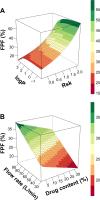Empirical modeling of the fine particle fraction for carrier-based pulmonary delivery formulations
- PMID: 25653522
- PMCID: PMC4310720
- DOI: 10.2147/IJN.S75758
Empirical modeling of the fine particle fraction for carrier-based pulmonary delivery formulations
Abstract
In vitro study of the deposition of drug particles is commonly used during development of formulations for pulmonary delivery. The assay is demanding, complex, and depends on: properties of the drug and carrier particles, including size, surface characteristics, and shape; interactions between the drug and carrier particles and assay conditions, including flow rate, type of inhaler, and impactor. The aerodynamic properties of an aerosol are measured in vitro using impactors and in most cases are presented as the fine particle fraction, which is a mass percentage of drug particles with an aerodynamic diameter below 5 μm. In the present study, a model in the form of a mathematical equation was developed for prediction of the fine particle fraction. The feature selection was performed using the R-environment package "fscaret". The input vector was reduced from a total of 135 independent variables to 28. During the modeling stage, techniques like artificial neural networks, genetic programming, rule-based systems, and fuzzy logic systems were used. The 10-fold cross-validation technique was used to assess the generalization ability of the models created. The model obtained had good predictive ability, which was confirmed by a root-mean-square error and normalized root-mean-square error of 4.9 and 11%, respectively. Moreover, validation of the model using external experimental data was performed, and resulted in a root-mean-square error and normalized root-mean-square error of 3.8 and 8.6%, respectively.
Keywords: deposition modeling; empirical modeling; feature selection; fine particle fraction; genetic programming; pulmonary delivery.
Figures






Similar articles
-
Adaptive neuro-fuzzy modeling of poorly soluble drug formulations.Pharm Res. 2006 Jun;23(6):1157-64. doi: 10.1007/s11095-006-0021-3. Epub 2006 May 25. Pharm Res. 2006. PMID: 16715373
-
Empirical search for factors affecting mean particle size of PLGA microspheres containing macromolecular drugs.Comput Methods Programs Biomed. 2016 Oct;134:137-47. doi: 10.1016/j.cmpb.2016.07.006. Epub 2016 Jul 6. Comput Methods Programs Biomed. 2016. PMID: 27480738
-
Study on the Pulmonary Delivery System of Apigenin-Loaded Albumin Nanocarriers with Antioxidant Activity.J Aerosol Med Pulm Drug Deliv. 2017 Aug;30(4):274-288. doi: 10.1089/jamp.2016.1316. Epub 2017 Mar 10. J Aerosol Med Pulm Drug Deliv. 2017. PMID: 28282259
-
In vitro/in vivo comparisons in pulmonary drug delivery.J Aerosol Med Pulm Drug Deliv. 2008 Mar;21(1):77-84. doi: 10.1089/jamp.2007.0643. J Aerosol Med Pulm Drug Deliv. 2008. PMID: 18518834 Review.
-
Dry powder aerosol delivery systems: current and future research directions.J Aerosol Med. 2006 Spring;19(1):21-7. doi: 10.1089/jam.2006.19.21. J Aerosol Med. 2006. PMID: 16551211 Review.
Cited by
-
Pulmonary Drug Delivery of Antimicrobials and Anticancer Drugs Using Solid Dispersions.Pharmaceutics. 2021 Jul 10;13(7):1056. doi: 10.3390/pharmaceutics13071056. Pharmaceutics. 2021. PMID: 34371747 Free PMC article. Review.
-
The future of dry powder inhaled therapy: Promising or discouraging for systemic disorders?Int J Pharm. 2022 Feb 25;614:121457. doi: 10.1016/j.ijpharm.2022.121457. Epub 2022 Jan 10. Int J Pharm. 2022. PMID: 35026316 Free PMC article. Review.
-
Effect of roll compaction on granule size distribution of microcrystalline cellulose-mannitol mixtures: computational intelligence modeling and parametric analysis.Drug Des Devel Ther. 2017 Jan 18;11:241-251. doi: 10.2147/DDDT.S124670. eCollection 2017. Drug Des Devel Ther. 2017. PMID: 28176905 Free PMC article.
-
Uncovering Biologically Coherent Peripheral Signatures of Health and Risk for Alzheimer's Disease in the Aging Brain.Front Aging Neurosci. 2018 Nov 29;10:390. doi: 10.3389/fnagi.2018.00390. eCollection 2018. Front Aging Neurosci. 2018. PMID: 30555318 Free PMC article.
-
Computational intelligence models to predict porosity of tablets using minimum features.Drug Des Devel Ther. 2017 Jan 12;11:193-202. doi: 10.2147/DDDT.S119432. eCollection 2017. Drug Des Devel Ther. 2017. PMID: 28138223 Free PMC article.
References
-
- Pilcer G, Wauthoz N, Amighi K. Lactose characteristics and the generation of the aerosol. Adv Drug Deliv Rev. 2012;64(3):233–256. - PubMed
-
- Hassan MS, Lau R. Inhalation performance of pollen-shape carrier in dry powder formulation: effect of size and surface morphology. Int J Pharm. 2011;413(1–2):93–102. - PubMed
-
- Chinga G, Johnsen PO, Dougherty R, Berli EL, Walter J. Quantification of the 3D microstructure of SC surfaces. J Microsc. 2007;227(Pt 3):254–265. - PubMed
Publication types
MeSH terms
Substances
LinkOut - more resources
Full Text Sources
Medical

